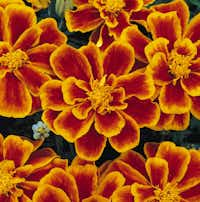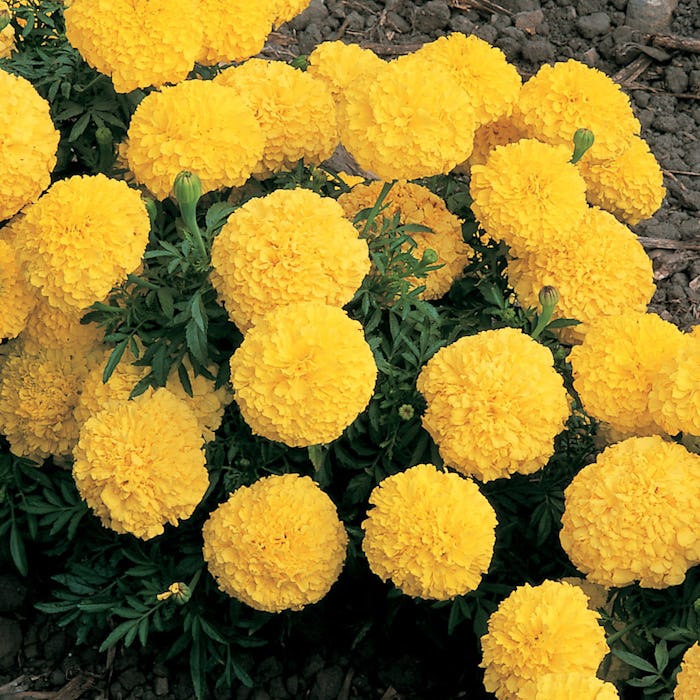

Tall Aztec marigolds
‘Sunset Giant’ is an heirloom blend of tall marigolds in orange, gold and lemon yellow. Blossoms can be 5 inches across on stems nearing 3 feet tall. This mixture is a reliable performer in many gardens. Plant in the back of your garden bed to take advantage of their height.
‘Snowball Hybrid’ is a nearly pure white marigold with 3-inch hemispherical flowers on 2-foot stems. Place this heavy bloomer next to bright-colored zinnias or salvias for color contrast. ‘Snowball Hybrid’ is also a good cutting marigold.
‘Moonsong Deep Orange’ produce huge, double flowers that are constant bloomers during the growing season. Stems grow about 15 inches tall with thick foliage to shade the roots. ‘Moonsong Deep Orange’ also attracts butterflies.
‘Moonstruck Yellow’ produces a bright yellow pom-pom flower that withstands heat and humidity. The 5-inch-wide blossoms make quite an impact growing on stems only a foot tall. ‘Moonstruck Yellow’ will continue to bloom into fall. It is said to be deer-resistant.

Smaller French marigolds
‘Super Hero Spry’: New for 2018 and an All-America Selectionwinner, this petite marigold has dark maroon outer petals contrasting with inner golden petals. ‘Super Hero Spry’ grows about a foot tall and requires no deadheading (removal of spent blossoms) for continued flowering.

‘Inca II Hybrid’: Bred from the popular ‘Inca Hybrid’ mix, this trio of marigolds has flowers in yellow, gold and orange shades. Although only a foot high, ‘Inca II Hybrid’ marigolds produce flowers up to 4 inches wide.

‘Durango’: If you enjoy strong colors in your garden, grow members of this petite marigold family. You can choose between ‘Durango Red’ in a deep maroon, ‘Durango Bolero’ in yellow with splashes of red, ‘Durango Flame’ with fiery markings, and several other Durango color combinations. All grow to about 10 inches high and attract bees. They are especially eye-catching in mass plantings.
‘Queen Sophia’: Expect large, showy blossoms that change colors as they mature. They begin as a dark bronze and gradually mature into russet petals fringed with gold. The plant grows about 10 inches high and 6 inches wide.
‘Red Metamorph’: This small marigold flower changes color with the seasonal change in daily temperatures. It begins in cool weather as a deep burgundy. As summer warms, the flower petals sport splashes of gold. Then when temperatures drop again in fall, the deep burgundy returns. ‘Red Metamorph’ can grow as much as 2 to 3 feet tall in ideal conditions.

Growing tips
Although marigolds are commonly available growing in six-packs at garden nurseries, don’t be shy about growing them from seed. Sow marigold seed in a growing medium about six weeks before the last frost. Once the weather is sufficiently warm, you can also sow marigold seeds directly in the garden or a container.
Consult the label or seed packet to see how tall they will grow. Plant the taller Aztec varieties toward the back so they will provide a colorful background for other plants. The petite French marigolds are best kept in the front or in containers.
Marigolds grow best in full sun locations, something North Texas gardeners have in abundance, and prefer soil with good drainage. Soggy soil can cause root damage and death.
Marigolds will give you a steady supply of blooms through summer, even in poor soils. In fact, a garden bed that is overly rich with nutrients will encourage the marigolds to produce more leaves than flowers.
The taller Aztec marigolds can be at a disadvantage in North Texas, where the winds are sometimes strong enough to topple these flowers. Plant in areas with some protection from high winds or be prepared to stake them. Insert a stick about 6 inches from the plant’s center. Using garden twine, loosely bind the stems to the stick. This will provide the extra support needed during windy periods.
Marigolds are susceptible to sucking insects. Watch for signs of spider mites (fine webbing within the leaf area), aphids on new growth, or thrips in the flower heads. Applying insecticidal soap over several days should eradicate these pests.
[“Source-dallasnews”]











